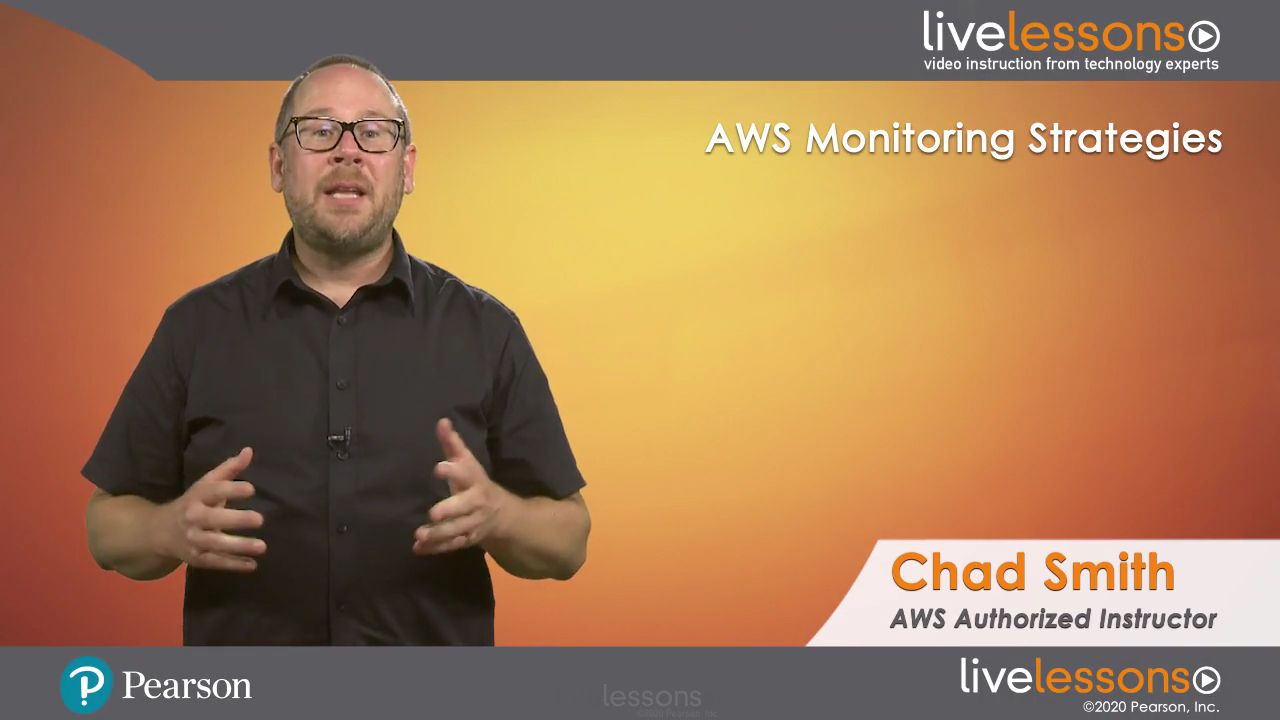AWS Monitoring Strategies LiveLessons (Video Training)
- By Chad Smith
- Published Nov 19, 2019 by Addison-Wesley Professional.
Online Video
- Your Price: $239.99
- List Price: $299.99
- About this video
Video accessible from your Account page after purchase.
Register your product to gain access to bonus material or receive a coupon.
Description
- Copyright 2020
- Edition: 1st
- Online Video
- ISBN-10: 0-13-661187-7
- ISBN-13: 978-0-13-661187-5
3+ Hours of Video Instruction
Overview Implementing effective monitoring in Amazon Web Services (AWS) requires a fundamental understanding of several services and features in the ecosystem. AWS Monitoring Strategies Livelessons was specifically created to focus on monitoring in AWS to explain the various tools available in the AWS ecosystem for monitoring, including performance, availability, log, and security monitoring features.
Monitoring is a critical piece of infrastructure that is often neglected. Monitoring in the cloud, and in AWS specifically, requires knowledge of specific principles as well as hands-on experience working with monitoring services and features. This course is dedicated to providing that knowledge, along with enough demonstrations to show how implementation actually works.
Skill LevelBeginner/Intermediate
Learn How To * Determine the best monitoring services for your situation* Determine the difference between passive and active response* Use CloudWatch Dashboard* Navigate a Route 53 Failover and Route 53 health checks* Use logs and metrics to determine what is happening to your system* Use thresholds and alarms* Use CloudTrail, GuardDuty, AWS Config, and AWS Systems Manager
Who Should Take This Course * AWS architects* AWS SysOps professionals* AWS security professionals* Beginner to intermediate AWS users
Course Requirements* Basic understanding of the AWS ecosystem and infrastructure architecture* Working knowledge of traditional monitoring techniques* Experience with automation strategies, including scripting languages
Lesson descriptions
Lesson 1, "Foundations of Monitoring," covers the elements of a 360-degree view of infrastructure and the differences between passive and active responses to alarms.
Lesson 2, "Monitoring in AWS Overview," discusses how monitoring in AWS differs from monitoring traditional architectures in an on-premises data center. Monitoring access, permissions are covered along with hybrid architectures and how they make monitoring more complicated.
Lesson 3, "Performance Monitoring," introduces CloudWatch and its dashboard feature, as well as custom metrics. Demonstrations of using dashboards and installing the CloudWatch Agent on an EC2 instance are provided. This lesson finishes with a real-world scenario comparing a third-party monitoring solution against AWS.
Lesson 4, "Availability Monitoring," starts with a discussion on status checks and which services use them, and then moves into a demonstration of how to implement EC2 instance reachability alarms. Lesson 4 finishes with Route 53 failover, along with a demonstration of the creation and management of Route 53 health checks.
Lesson 5, "Log Monitoring," details how to perform log monitoring in AWS. Logs are divided into separate topics, starting with access and execution logs. The features used to monitor this are discussed next, including CloudWatch Logs, Events, and Metrics Filters. After a demonstration of CloudWatch Events, the lesson ends with a discussion of log delivery from CloudWatch to S3.
Lesson 6, "Threshold and Alarms," discusses exactly that, and provides the tools to avoid designing monitoring that doesn’t actually work as intended, missing outages or being far too sensitive to be useful.
Lesson 7, "Access and Compliance Monitoring," is split into different services and features, depending on the type of monitoring required. This lesson starts with foundational principles with CloudTrail, then does a deeper dive into GuardDuty, followed by a demonstration. Use cases for config rules are explained, followed by a second demonstration, this time showing how to enable and configure AWS Security Hub. The lesson finishes with explanations of VPC Flow logs and AWS SSM and a demonstration of use cases for SSM for operations and mitigation.
Lesson 8, "Wrap-up," summarizes the building blocks covered throughout the course, showing how all the blocks have been covered with at least one service or feature. Finally, you learn some pointers on next steps that can be taken within specific services to improve monitoring skills and implementation.
About Pearson Video TrainingPearson publishes expert-led video tutorials covering a wide selection of technology topics designed to teach you the skills you need to succeed. These professional and personal technology videos feature world-leading author instructors published by your trusted technology brands: Addison-Wesley, Cisco Press, Pearson IT Certification, Prentice Hall, Sams, and Que. Topics include IT Certification, Network Security, Cisco Technology, Programming, Web Development, Mobile Development, and more. Learn more about Pearson Video training at http://www.informit.com/video.
Video Lessons are available for download for offline viewing within the streaming format. Look for the green arrow in each lesson.
Sample Content
Table of Contents
Lesson 1: Foundations of MonitoringLesson 2: Monitoring in AWS OverviewLesson 3: Performance MonitoringLesson 4: Availability Monitoring Lesson 5: Log MonitoringLesson 6: Threshold and AlarmsLesson 7: Access and Compliance MonitoringLesson 8: Wrap-Up
